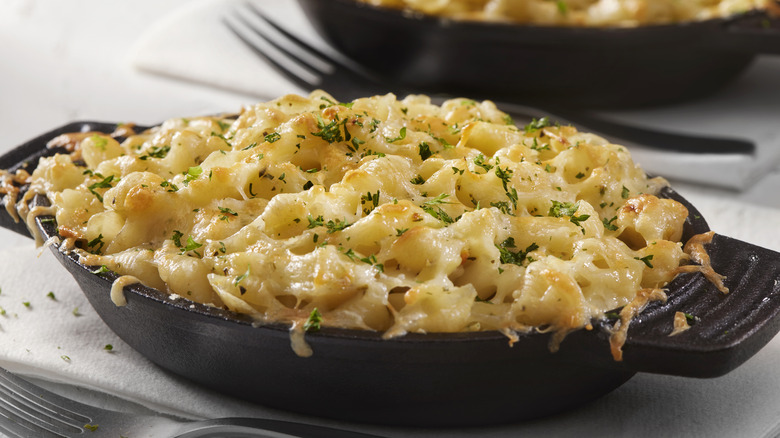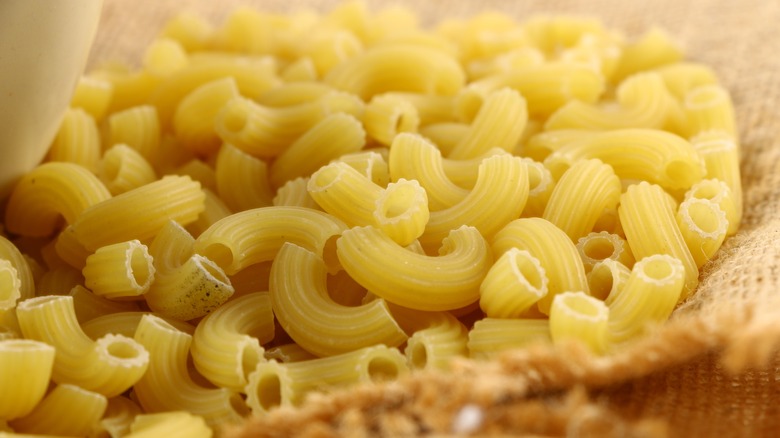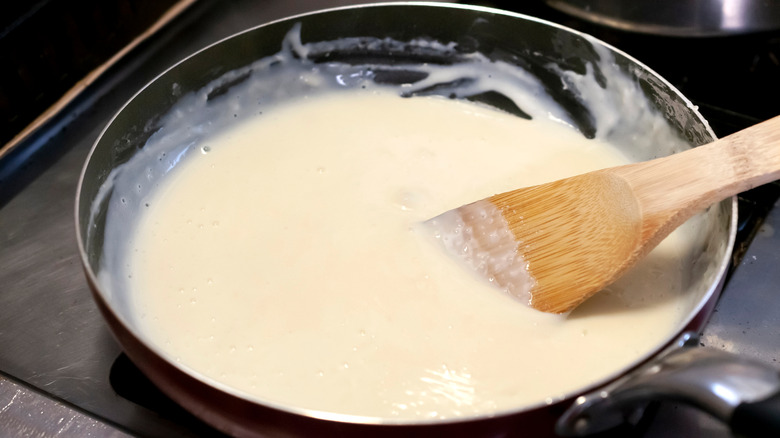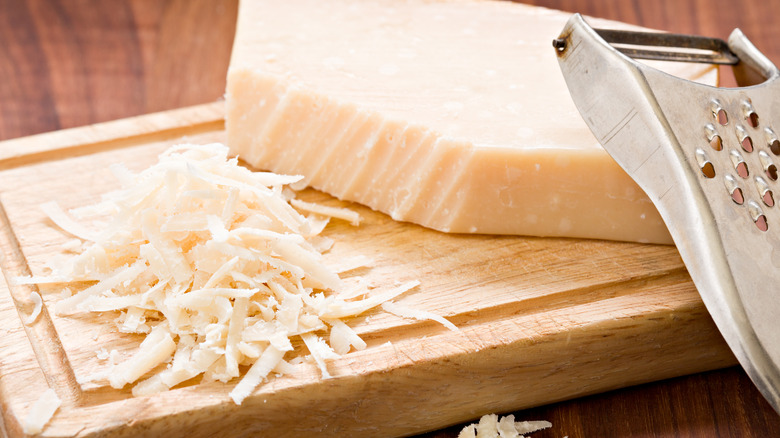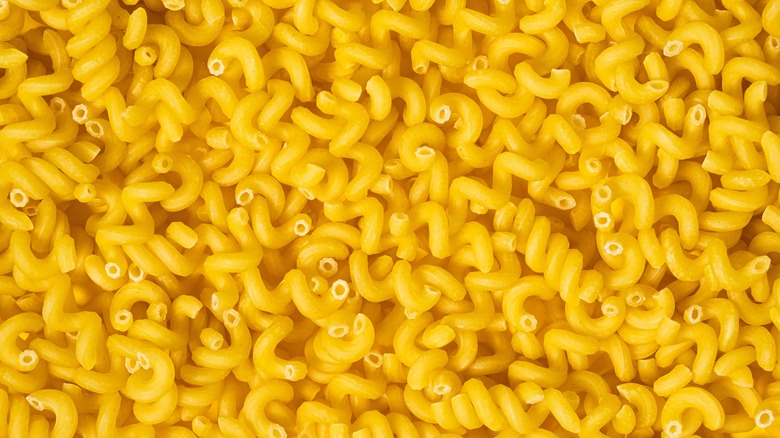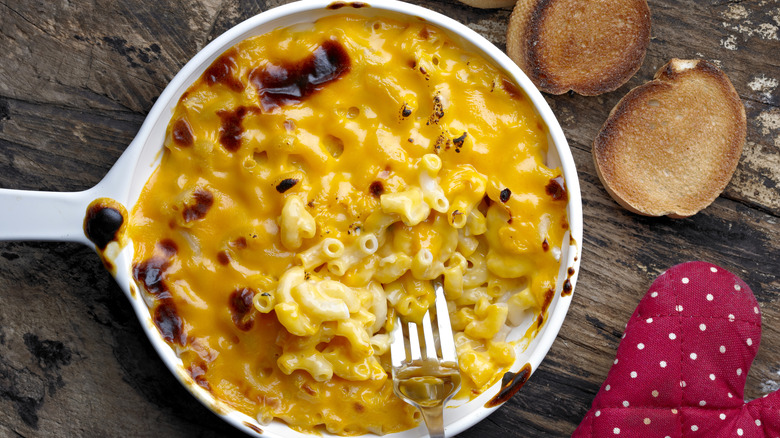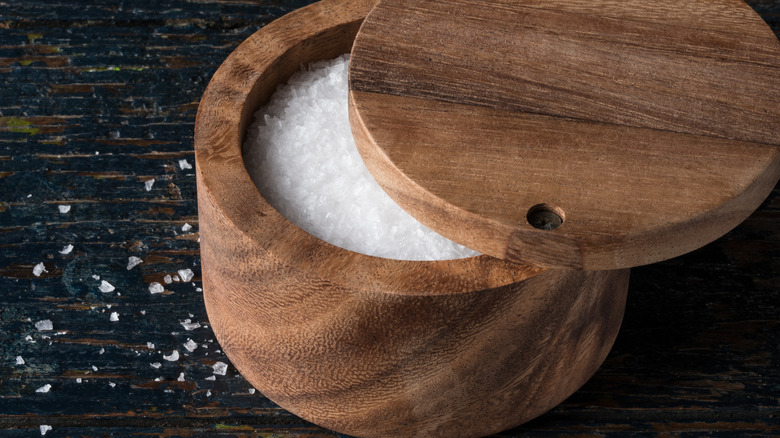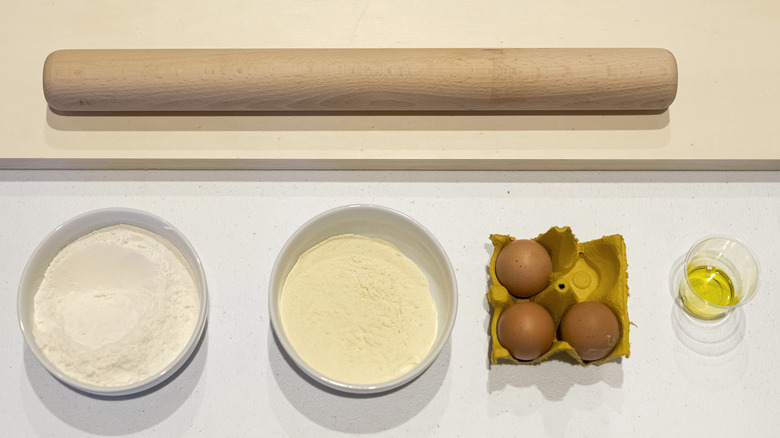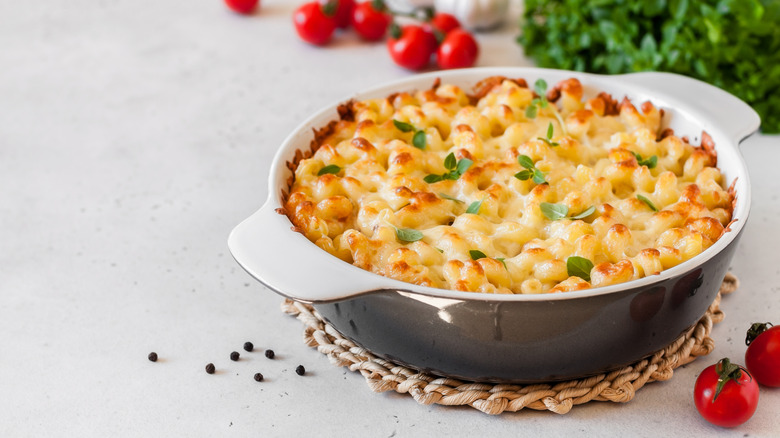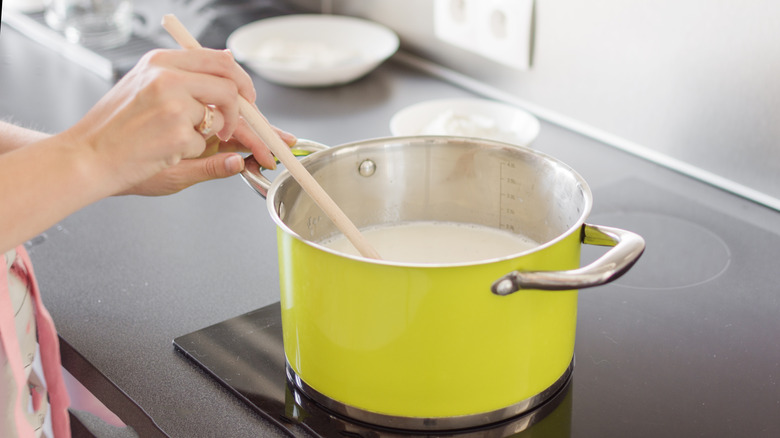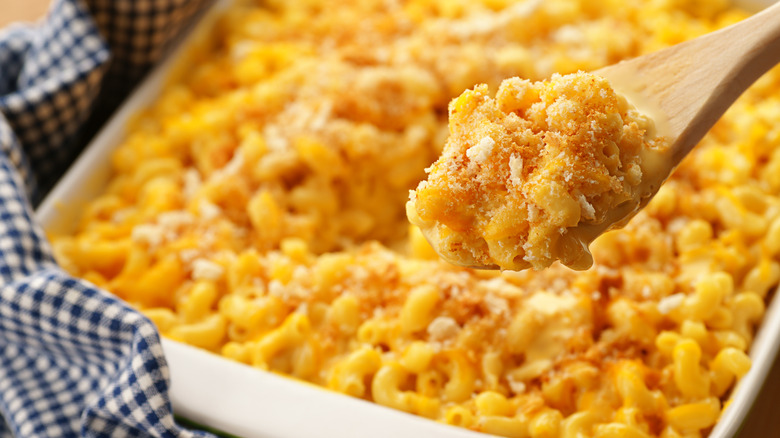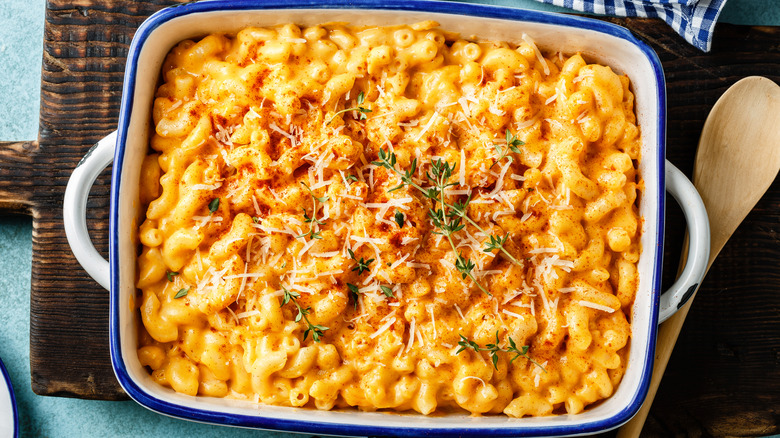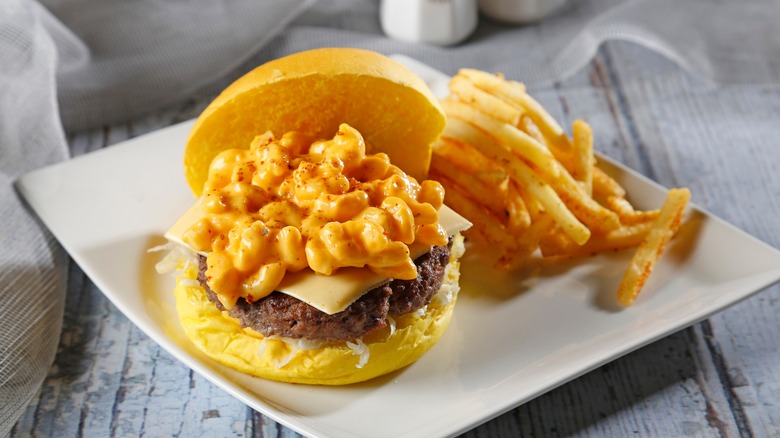13 Mistakes You're Probably Making With Homemade Mac And Cheese
There are a lot of comforting dishes out there, but in our view, homemade mac and cheese stands above them all. Combining pasta and cheese has been a culinary practice since the ancient Roman era, with the Roman Republic's Senator Marcus Porcius Cato including a recipe mixing the two in a written work in 160 B.C. The pairing lasted through the ages, reaching America in the 18th century before the advent of the processed food industry caused an explosion in popularity with the invention of processed cheese.
The mac and cheese many people now know, a concoction of elbow macaroni and a lurid cheese sauce made from Velveeta, can be found in boxed form in virtually every store. For every boxed mac and cheese, though, there's a homemade version, with recipes shared lovingly between friends and family members, producing bubbling tureens of cheesy pasta with a crunchy topping.
However, there's no denying that whipping up homemade mac and cheese is harder than making it from a box. It takes a surprising amount of culinary skill to ensure that your mac and cheese isn't too runny or thick or, crucially, hasn't cooked down into mush. Too many homemade mac and cheese dishes also suffer from a lack of flavor, seasoning, or even cheese. Avoiding some key missteps can help you prevent these things from happening to your pasta.
1. Overcooking your macaroni
One of the hardest things to nail with mac and cheese is the consistency of the pasta. Way too many versions end up with overcooked, soggy noodles that have released too much starch. This usually occurs due to fears that the macaroni you're using won't be cooked enough by the time it comes out of the oven, which then leads people to boil it for too long before it's mixed with the cheese sauce.
It's important to remember that the pasta will continue to cook in the oven, so slightly undercooking it is the way to go. You'll want to cook your macaroni until it's moderately "al dente," which translates to "to the tooth." Al dente pasta still has a firmness to it, with your teeth meeting some resistance as you bite through the noodles, but with no chalkiness.
To get al dente pasta, you should always taste test it as it's cooking. Even though some packages will indicate the time to work toward an al dente result, it's still possible for these to be a little overcooked for your liking. Scoop out a piece of macaroni around two to three minutes before your package recommends and cut or bite through it. If there's a white ring running around its middle, but it doesn't feel or taste chalky, it's just right.
2. Trying to rush your béchamel
Most homemade mac and cheese recipes start with a béchamel, or white sauce. This sauce is comprised primarily of butter, flour, and milk, which serves as a thick base for your cheese and gives the mac and cheese its structure, holding all of the pasta pieces together. Anyone who's ever made béchamel, though, will know that it's an exercise in patience: You need to add your milk to your roux (the mixture of butter and flour) slowly, a little at a time, whisking it constantly to incorporate the liquid.
However, too many people just pour in all their milk at once, which can leave your sauce with blobs of flour floating around in it, unincorporated. These lumps of flour can then end up in your mac and cheese, giving it an inconsistent texture. Avoid this by practicing restraint when making your sauce, particularly at the beginning. After you add a small amount of milk, whisk the roux thoroughly until smooth before pouring in the next batch. Once you've incorporated about half of your milk, you can then pour it in slightly faster. Remember that the roux will thicken gradually, so give each pouring of milk a good few minutes before you add the next load.
3. Using the wrong type of cheese
Kraft mac and cheese might have been your favorite dinner as a kid, but tastes change as you grow up — and have you tried Velveeta lately? The "cheese" that's used in Kraft mac may be nostalgic, but it's pretty much the worst choice you can make for your dish. Velveeta is classified as a "cheese product," made from dairy protein concentrates, fats, and preservatives, and while it might give your mac and cheese that bright yellow color, it will also make it taste artificial and bland simultaneously.
Velveeta is still the protein of choice for many people for homemade mac and cheese, but we would urge you to choose dairy products that have a little more flavor for the best result. Mixing several types of cheese, all with different flavor notes, is best. Sharp cheddar, Parmesan, and Gruyère is an excellent combination, with the cheddar and Parmesan providing sharpness and brininess and the Gruyère giving the dish a luxurious, velvety texture. Monterey Jack can also be used in place of cheddar if you like your cheese to be slightly milder. Avoid using cheeses with especially strong flavors, like those that have gone through a long aging process or goat cheese, unless you want your dish to be extra punchy. Additionally, remember to add enough cheese; it's a surprisingly common mistake to make, as the béchamel is already pretty creamy, but it's easy to be too restrained and lose flavor.
4. Only using elbow macaroni
As one half of mac and cheese — macaroni — is quite literally in the name of the dish, it can be easy to assume that's the only pasta you can use. However, that's far from the truth. While purists might disagree, we think that you can use a variety of different kinds of pasta in mac and cheese, with many shapes superior to macaroni in terms of their ability to hold the cheese sauce and give a more robust bite.
Take cavatappi, for example. "I think cavatappi is the best shape for mac and cheese, whether stovetop or baked," Chef Sydney Wilcox tells HuffPost. Wilcox points out that the pasta's corkscrew-like shape gives it more ability to capture the cheese sauce, giving each bite more flavor, and its larger shape makes it more satisfying. Tubular pasta like rigatoni and penne allow more cheese to get into their center, again improving the taste of every mouthful. Fusilli, meanwhile, is excellent for trapping the cheese sauce in its rivets.
Where you might struggle a little more is with super-small pasta shapes, like stelline or cavatelli, which can tend to disappear into the sauce. Long pasta like spaghetti, on the other hand, can be novel but can also get mushy fast and be tricky to cut and portion out cleanly.
5. Making it with pre-grated cheese
Mac and cheese, as you might expect, includes cheese — a lot of it. That can mean much of your preparation time is spent hunched over a box grater, which isn't exactly fun. To save time, many people reach for bagged pre-grated cheese, but doing this can alter the taste and texture of your dish pretty perceptibly.
Pre-grated cheese contains anti-clumping agents to keep the pieces separate, as well as preservatives. These ingredients can give your mac and cheese a slightly chalky flavor and also reduce the cheese's intensity and creaminess. In addition, they can also prevent your cheese from melting as effectively, affecting the smoothness of your béchamel.
If that all wasn't bad enough, pre-grated cheese can also be more expensive than a regular block for the same amount, with the higher cost reflecting the processing it's undergone. You're far better off buying regular cheese and grating it yourself. You can reduce the time this takes hugely by shredding your cheese in a food processor. This is especially useful if you're making a large dish or are using more of a hard cheese like Parmesan, which can take much longer to grate.
6. Under-seasoning your mac and cheese
If you've ever had mac and cheese that's weirdly lacking in flavor, it's likely down to a lack of seasoning. Mac and cheese takes a lot more flavor than you think, and while cheese generally has a high salt content, you need to remember that you're going to be mixing your sauce with a large amount of neutral-tasting pasta, which will diffuse its taste.
Therefore, make sure you're being bold with your seasonings. Add a generous pinch or two of salt to your béchamel to intensify all of its flavors. You should also remember to season your pasta water with salt before cooking your noodles to give them additional flavor.
Seasonings range far beyond just salt, though, and many additional ones can — and should — be added to give your mac and cheese extra layers of flavor. A generous amount of black pepper is crucial to offset the creaminess of the sauce, and a traditional pinch of nutmeg in your béchamel goes a long way to inject the dish with a gentle earthiness. For more boldness, try a few dashes of cayenne pepper for a spicy mac and cheese. Dried herbs can also play a part in giving your meal extra depth, with dried basil, oregano, and parsley all adding brightness.
7. Trying to use fresh pasta
It's generally assumed that fresh pasta is somehow the superior option to dried pasta, which is partly why many folks only buy it for special occasions. If you're looking to make a killer mac and cheese, though, don't be tempted to put fresh pasta in it. "Using fresh pasta always feels like a cool idea. That said, having had the chance to try it out, I don't think it delivers anywhere near the same experience or end result as dried pasta," Chef Ashley Christensen warns HuffPost. The issue with fresh pasta is that it's so much softer to begin with, so it's just not possible to get it to the al dente texture that you need for mac and cheese.
As a result, if you use fresh pasta, your noodles will completely overcook, and the dish will go sloppy. Any subtlety that comes from the flavor of the noodles will also be lost in the heavy cheese sauce. Instead, as Christensen states, "Dried noodles are so much more dependable, with [better] structural integrity" for mac and cheese. Leave your fresh pasta for dishes where they can take center stage with a simple, light sauce.
8. Forgetting to give it time to rest
Mac and cheese can be a pretty lengthy dish to put together. While the wait is always worth it, some people's appetites start to get the better of them once it's in the oven, and this can result in them digging into the dish immediately after pulling it out. This, however, is a huge error. If you don't give your mac and cheese time to rest after you remove it from the oven, it's likely to fall apart when you dig into it, not to mention burn your mouth. When your mac and cheese is too hot, it can also completely ruin its flavor, as any subtlety in your sauce and cheese will be indistinguishable in the scalding mess.
Instead, give your mac and cheese some time to rest. You should allow around 10 to 15 minutes for this, Chef Damon Menapace, culinary director of Primal Supply Meats, advises "Today": "This will allow the sauce to set back up around the noodles. Otherwise, it'll just be runny and ripping hot." Don't worry about your dish going cold, as the density of the mac and cheese will retain its heat effectively. You can use the time it takes to rest to top up any drinks, prepare your plates, and put together a quick green salad.
9. Making a sauce that's too thin
A thin mac and cheese sauce is a surefire way to ruin the dish. This can often occur if you've added too much liquid to your white sauce or haven't added enough cheese to thicken it up. If you try to use a béchamel that's too thin, your dish simply won't have the structure it needs. Additionally, your pasta and sauce will remain largely distinct from each other, and it will drip away from the macaroni pieces at the top of your dish, leaving them flavorless and more prone to burning.
Thickening your sauce is not something you should attempt once it's been mixed with your pasta, especially by trying to cook it for longer, as this will leave you with overcooked noodles. So, make sure you tackle it before you combine your two ingredients. One of the easiest ways to do this is to add some more cheese, which will give it more bulk (and more flavor). You can also simmer your béchamel for a little bit longer, as this will help to evaporate some of its liquid. Just make sure you do this on low heat, so as not to scorch the sauce at the bottom. If you elect to add some more flour or cornstarch to thicken it, combine it with a little water before pouring it in; trying to sprinkle it into the sauce will leave it unincorporated.
10. Trying to tweak your recipe too much
Mac and cheese is both a delicious standalone dish and an excellent base for other flavors. One error people always make, however, is to load it up with a million additional ingredients. Whether this is to make it taste better or to make it more substantial, it's a practice that you should avoid leaning too much into. By adding too many ingredients in, not only do you alter the flavor of your dish, overwhelming it with too many tastes, but you also turn it into another meal entirely. It's also worth bearing in mind that mac and cheese is a super-hearty meal in itself, and you may not need to throw in loads of extras for it to be satisfying.
Additionally, you should avoid making too many substitutions with your ingredients if you want the same result. "You can definitely get away with using low-fat or nonfat milk, but don't let it get too far away from its ooey, gooey, cheesy self!" "Girl Meets Farm" host Molly Yeh tells "Today." Trying to skimp too much on some of the main elements in the meal, like milk and cheese, will result in a reduction in flavor that can't really be brought back.
11. Forgetting to add a topping
While mac and cheese shines for its simplicity and its minimal ingredients, there is one addition we'd always advocate for: a crunchy topping. Topping your mac and cheese adds a textural profile that's missing from the base dish, with the crunch working incredibly well with the creamy pasta. As well as this, your topping is an opportunity to add further flavor. It also has a protective function and can prevent the pasta underneath from burning in the oven.
Adding a topping can be as simple as merely sprinkling breadcrumbs over the dish before you bake it, but you can push it even further than that. Crushed potato chips, for instance, can give the dish sharpness and saltiness, and opting for a barbecue or sour cream flavor will inject new dimensions into your mac and cheese. Crispy fried onions can deliver a smack of umami to the dish, whereas crushed butter crackers can give it added smoothness and a little bit of sweetness. You can mix all of these toppings with some extra grated cheese, which will crisp up and create a protective dome over your pasta, as well as give it even more cheesy goodness.
12. Baking your mac and cheese for too long
Mac and cheese is generally a pretty robust dish, and cooking it for a few minutes extra is unlikely to do any significant damage. Leave it in the oven for way too long, though, and that's another story. Over-baking your mac and cheese will cause the noodles inside to overcook and jellify, losing all of their bite. It can also burn the top of your dish — and, perhaps worst of all, dry everything out way too much.
If your mac and cheese has been cooked for too long, it's quite tricky to salvage it, and you may need to start again. However, if overcooking has caused it to dry out instead of become too mushy, there are some steps you can take to fix it while it's cooking. Adding in a little bit of milk, cream, or water and stirring it through can help to loosen the dish and provide moisture. Bear in mind that you'll only want to do this if you haven't added a topping to your mac and cheese, as trying to stir it in will break this up and distribute it throughout the pasta. You should also remember that this method will only work if your pasta is still al dente. Adding moisture to fully cooked pasta and continuing to cook it will result in it falling apart.
13. Serving it the same way every time
Perhaps the biggest crime with mac and cheese is dishing it up unadventurously. We prefer our mac and cheese to be made of a few quality ingredients and not be overstuffed with extras, but that doesn't mean it can't be served in combination with other dishes in innovative ways. Next time you make mac and cheese, for instance, pause before you put it in the oven and toss it in the refrigerator instead. Once hard, cut the cheesy pasta into rounds and then stuff it into burger meat for a mac and cheese stuffed burger that'll blow your guests' minds.
Mac and cheese can also be used as a topping for an ultra-indulgent pizza, spooned onto a baked potato, or spread on top of a hot dog. Or, roll some chilled macaroni and cheese in some breadcrumbs and then deep-fry them for a take on arancini balls. Alternatively, mix up the accompaniments you serve with it: If you're used to having mac and cheese with a green salad, try a coleslaw instead, or some steamed broccoli. These simple changes can add a lot of flavor and excitement.
